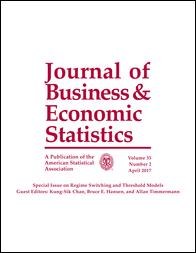
Hurlin, C., Laurent, S., Quaedvlieg, R. and Smeekes, S. (2017). Risk Measure Inference Journal of Business and Economic Statistics, 35(4):499--512.
-
Affiliated authorRogier Quaedvlieg
-
Publication year2017
-
JournalJournal of Business and Economic Statistics
We propose a bootstrap-based test of the null hypothesis of equality of two firms{\textquoteright} conditional Risk Measures (RMs) at a single point in time. The test can be applied to a wide class of conditional risk measures issued from parametric or semi-parametric models. Our iterative testing procedure produces a grouped ranking of the RMs, which has direct application for systemic risk analysis. Firms within a group are statistically indistinguishable form each other, but significantly more risky than the firms belonging to lower ranked groups. A Monte Carlo simulation demonstrates that our test has good size and power properties. We apply the procedure to a sample of 94 U.S. financial institutions using ?CoVaR, MES, and %SRISK. We find that for some periods and RMs, we cannot statistically distinguish the 40 most risky firms due to estimation uncertainty.